- Top Games Like Overwatch - January 20, 2023
- Best Healer in Overwatch Guide - January 4, 2023
- Overwatch 2 Character Tier List - December 31, 2022
Arena of Valor is MOBA that most people refer to as a League of Legends clone. It is a free-to-play game where two teams of five battle each other as they try to take down the enemy base. Each player controls a powerful individual known as a hero.
Like in all MOBAs, every hero has a role to play. We categorize them as assassins, mages, marksmen, supports, tanks, and warriors. Heroes get stronger as the game progresses by accruing gold and experience. They can acquire up to 6 magical items and reach a maximum level of 15. Each hero has two basic spells, one passive ability, and an ultimate ability.
Despite being a mobile game, Arena of Valor can be very complex, especially if you have never played MOBAs. It requires a lot of coordination and strategizing to meet your game objectives. Unfortunately, like other similar games, it can sometimes be infuriating.
Key Info Up Front
Arena of Valor is a mobile MOBA game where two teams of 5 clash against each other, trying to destroy the opponents’ base. Each player controls a powerful hero with a unique set of abilities. As the game progresses, you gain gold and experience, allowing you to buy items, and improve your spells.
Background
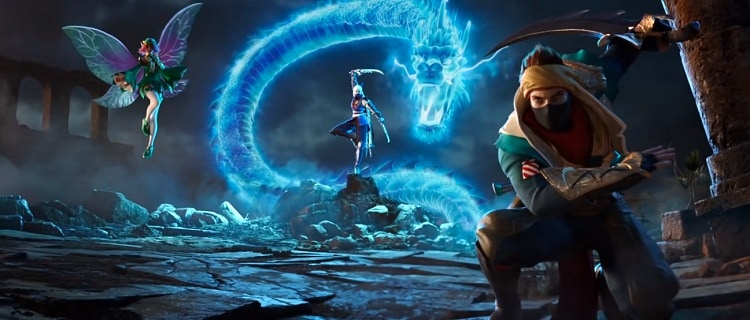
Over time, Arena of Valor received a lot of backlash for resembling League of Legends. However, it is worth noting that the game by TiMi, a Riot Games sister company, made League of Legends. Both of these entities are subsidiaries of a larger organization, Tencent.
Arena of Valor, which was initially called Strike of Kings, is an adaptation of another TiMi MOBA called Honor of Kings, a game that was only available in China. Level Infinite released this game for iOS and Android (2016) as well as Nintendo Switch (2018) on foreign markets.
Since September 2018, the company has made $140 million in gross profit outside China. What’s even more remarkable is that this is just one out of six games played during the renowned 2018 Asian Games. It was also featured during other major Asian esports events making it one of the most popular competitive titles in this part of the world.
Game Modes
Arena of Valor features numerous games modes:
Antaris Battlefield
Antaris Battlefield is the game’s main map, similar to Summoner’s Rift in League of Legends. Players also refer to this mode as Grand Battle. You play this map during Ranked games. When we talk about Arena of Valor, we commonly refer to this mode.
Antaris Battlefield matches are 5 vs. 5. An average game lasts for about 12 to 20 minutes, during which time you will commonly reach the maximum level and fill all 6 item slots.
To finish the game, you need to focus on completing main objectives such as destroying all turrets on the map and killing the Dark Slayer and the Abyssal Dragon Kraydus. A team wins the game when they take down the enemy Core.
Clone Clash
The rules for Clone Clash are basically the same as for Antaris Battlefield map. The only difference is that all heroes on the map are the same (both allies and enemies).
Valley Skirmish
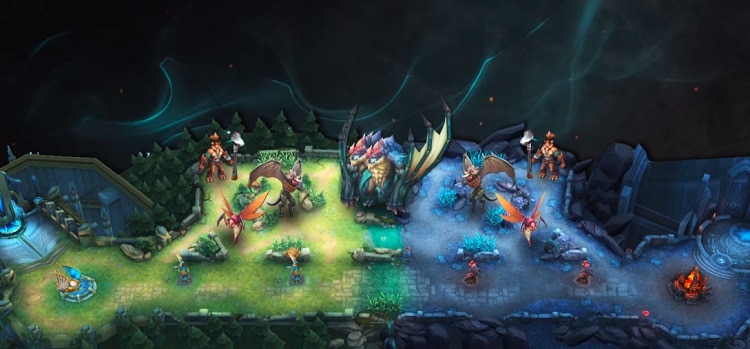
Valley Skirmish or Shadow Duel is the game’s 3 vs. 3 mode. As you can presume, the teams battle on a significantly smaller map, Flatland Battlefield. The map has only one lane and one turret.
The Valley Skirmish matches are much faster, lasting approximately 5 minutes. They are also much more chaotic as you have 6 players in the lane from the get-go. There is a giant monster called Garnak above the lane, which gives you a powerful buff when you kill it.
Abyssal Clash
Abyssal Clash is another crazy map where two teams of five face each other. The cool thing about this mode is that there is just one lane. Everyone is squeezed together in a small space in a continuous brawl. You get a random hero at the beginning and can reroll your character once.
Unlike other modes, there are no neutral monsters on Abyssal Clash, but there are still minions. Each team has two turrets, and there is a lot of brush on the sides, providing some cover. Small health globes spawn at specific positions on the map, providing quick restoration. Lastly, you can only purchase items while in the base. So, suiciding into the enemy’s Core is sometimes a valid strategy.
Black City Arena
Black City Arena map is somewhat similar to the Abyssal Clash map. It is a 1 vs. 1 mode that allows you to face a trash talker from the opposing team. Each player has a turret and a core. There are two sets of brushes and health globes that provide quick regeneration. Like with the Abyssal Clash mode, there are no neutral monsters.
Hook Wars
Hook Wars are very similar to Dota’s Pudge Wars. This is a 5 vs. 5 map where every character is the same. That is, you can only use the hook ability that allows you to reel in enemies. This map has no power-ups, minions, monsters, turrets, or Cores.
The point of the game is to remain in the central control zone for as long as possible. The opponents’ control zone is on the other side, and they will try to hook you whenever they get a chance. The game ends when a counter reaches 100%.
Death Match
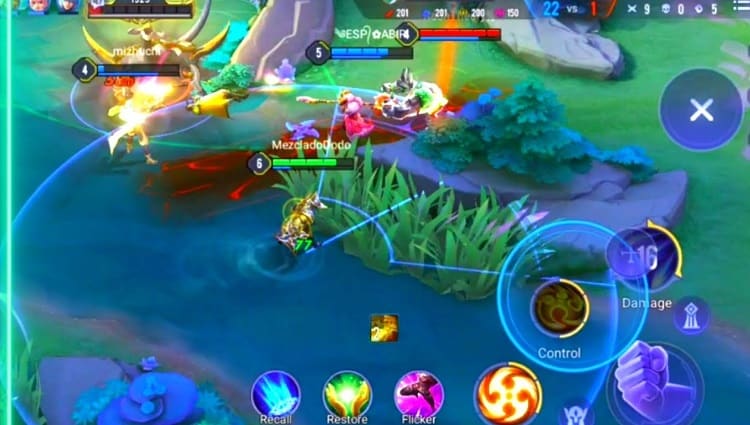
The mode features 5 teams of 2 players who wage war on a unique pentagonal map, Death Realm. Unlike standard modes, there are no turrets or minions on Death Match. Each team has its starting position on one of the pentagon edges.
The game lasts 8 minutes, during which each team tries to accrue as many points as possible by killing opposing heroes. There are specific events at fixed intervals that add to the mode’s dynamic. For example, monsters with buffs will spawn at designated locations. When 8 minutes are over, you can check the scoreboard to see how each team performed.
Gladiator’s Summit
Like in Clone Clash, each player gets a random hero at the start of Gladiator’s Summit, and you get one chance to reroll a character. The dope thing about this mode is that there is no mana or energy cost for the abilities. The basic spell cooldowns and talent cooldowns are reduced by 70%, so you can practically spam as much as you want.
Mayhem Mode
As the name implies, Mayhem Mode is quite hectic. It uses a new Horizon Valley map where two teams of 10 engage each other, trying to destroy the enemy’s Core. You can use Astral Coins to further improve characters’ abilities and attributes.
Football Fever
Football Fever is a 3 vs. 3 mode where teams play football. It is on the Fantasy Island map that looks like a large football field with a beach theme. To score goals, you need to use an ability called Kick. The talent has a line cast, allowing a player to kick a ball in a specific direction.
Duo-Race
Duo-Race is Arena of Valor’s racing mode where 5 teams of 2 face each other. The race lasts for two laps, and, as it usually goes, the first team to cross the line wins the race. The cool thing about Duo-Race is that you can turn your hero into a vehicle and help the teammate.
Game Basics
In this Arena of Valor guide, I will focus on the standard Antaris Battlefield map as the most popular mode. The game basics are very similar to those of League of Legends and Dota 2, so if you have experience with these games, it shouldn’t be that hard to catch up.
Antaris Battlefield Map
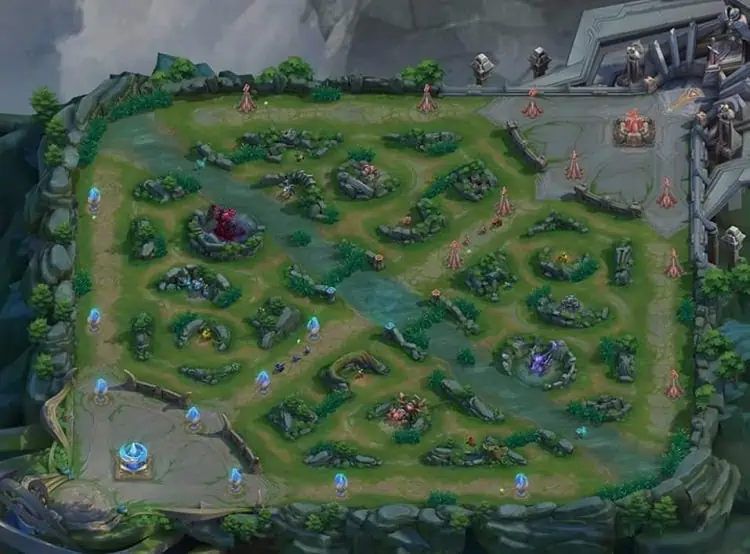
Antaris Battlefield is almost a carbon-copy of League of Legends Summoner’s Rift. The most significant difference is the Arena of Valor map doesn’t have inhibitors. Overall, the battlefield feels much smaller, which makes sense given that this is a mobile game.
The map consists of three lanes: the bottom lane (bot lane), middle lane (mid lane), and top lane. There is a large section of ground between these lanes that we call the jungle. Here is where neutral monsters spawn, including the Dark Slayer and the Abyssal Dragon.
There are three turrets in each lane. You can start attacking the enemy Core once you destroy all three in one lane. Although destroying all turrets on the map is not necessary to achieve victory, it does provide increased map control while reducing enemy vision.
Like in other games, minions spawn in each lane and push towards the enemy base. They are cannon fodder that allows your heroes to destroy turrets without taking damage themselves. Dealing a killing blow to a minion gives gold to your hero. The main difference between Arena of Valor and other MOBAs is that minions do not spawn at regular intervals.
Game Phases
There are three main phases of the game: early phrase or laning phase, mid game, and late game.
Early Game
During the early game, heroes are mostly static in their respective lanes. They try their best to kill enemy minions and accrue as much gold and experience as possible.
They also try to pressure enemy heroes and reduce their own farm (gold acquisition rate). Except for junglers, characters that start the game from the jungle, there isn’t much movement between lanes.
Mid Game
During the mid game, heroes slowly start abandoning their lanes and grouping up. They occupy other lanes and try to take game objectives such as destroying turrets. Certain team compositions have a significant advantage during mid game, so it is in their interest to play aggressively during this phase of the game.
Late Game
Lastly, during the late game, your carry heroes become extremely powerful and can destroy the enemy team by themselves. Nevertheless, during this stage of the game, teams are almost exclusively fighting 5 on 5.
In this stage of the game, you’re looking to destroy tier 3 turrets, kill the Destroyer, and end the game. Almost everyone on the battlefield is max level and with full item slots.
Team Composition and Roles
To maximize your chance of winning, you need to have a balanced team composition. Ideally, you should have a tank, a support, a carry, a mage, and fighter/assassin. The optimal composition might vary a little bit. Depending on your strategy, you might not need some of these roles.
The critical thing to keep in mind is that not everyone can farm. Some players have to sacrifice for the greater good, and their role is to provide support and do their best with limited resources. This is why you should almost always have a support on your team, as this is the most gold-independent role.
In a typical scenario, you will have a tank in the top lane, a fighter/assassin in the jungle, a mage in the mid lane, and carry plus support in the bottom lane. Carry is the backbone of every team. With enough time, this can become the most powerful character on the map, but it needs some support in the early game.
Monsters
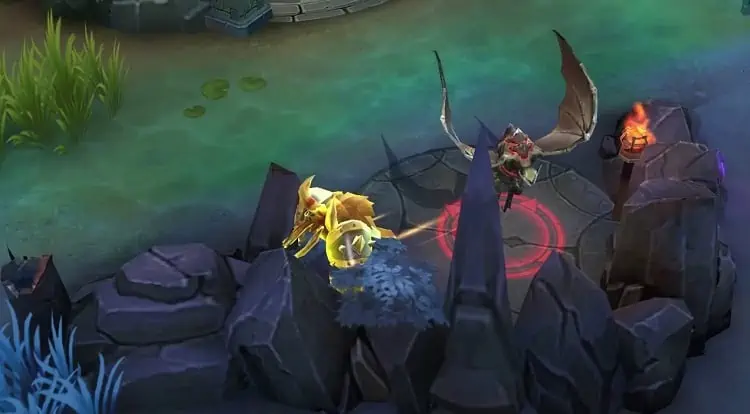
Jungle monsters are a crucial part of the game, and they can provide a decisive advantage to a team that is struggling to finish a match. Aside from providing gold and experience boost, they also give your team powerful, temporary buffs.
Here are some monster basics:
Seagle
These are basic monsters that patrol through certain areas of the jungle. They are passive and won’t attack you even when you start damaging them. Upon killing a Seagle, a light entity spawns and starts patrolling the enemy part of the jungle, warning heroes in lanes of potential ganks.
Might and Sage Golem
Killing Might Golem provides damage over time and slows your auto-attacks while destroying Sage Golem gives you mana regeneration and cooldown reduction. Might Golems’ buff is better for auto-attacking characters, and Sage Golems’ is better for casters.
Spirit Sentinel
This is a slightly more powerful enemy. It provides massive health regeneration and movement speed for 60 seconds. The movement speed buff becomes even better when you’re out of combat. Unlike the Abyssal Dragon and the Dark Slayer, you don’t need other teammates to take him down.
Abyssal Dragon
Abyssal Dragon provides a great boost to gold and experience. After 10 minutes, it evolves into the Enraged version of itself, providing additional buffs depending on character class.
For example, a tank will get 1% max health regeneration, and a mage will get increased ability power. It also drops Abyssal Stone, an item that basically prevents the wearer’s death and is consumed afterward.
The Dark Slayer
This is the most powerful monster on the map, and you commonly need the whole team to take it down. The team who took it down will get 1% health and mana regeneration for 90 seconds and a temporary movement buff after scoring a kill.
Most importantly, killing the Dark Slayer allows you to summon a powerful Drake creature for the next 90 seconds, making it easier to destroy enemy turrets and Core.
Heroes
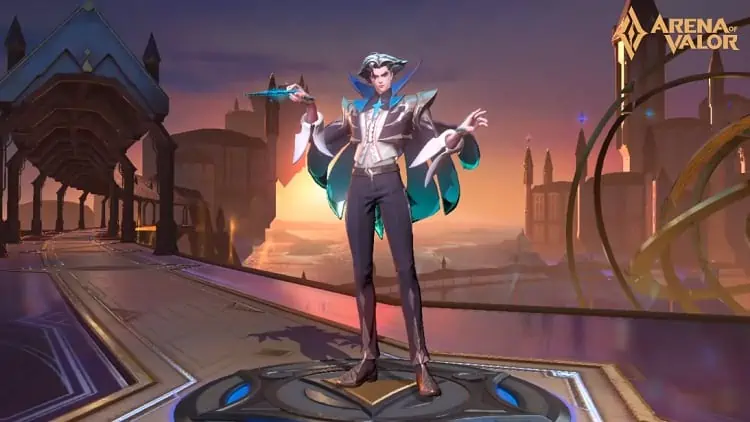
There are currently 112 heroes in the game, with each one of them belonging to a certain class. Unlike other MOBAs, you have to reach a certain proficiency level with a hero so you can use it in Ranked Games. This prevents poor performance by players who like to experiment.
Here is a breakdown of all hero classes:
Assassins (Paine, Keera, Flash, Wukong, etc.)
These characters are great at charging enemy backlines and quickly disposing of squishy targets, such as mages. They have extremely high damage but very poor defense. To play an assassin class, you need to be opportunistic and find holes in enemy defense.
Assassins usually have abilities that allow them to get into the fray and get out after scoring a kill. The class focuses on offensive items and is regarded as glass cannon.
Mages (Aleister, Lorion, Marja, Iggy, etc.)
Mages combine high magical damage output with crowd control spells. They are usually great against all classes as they can kill off squishy targets and kite enemies with high defense. However, they often struggle against assassins who can easily burst them down.
Although they are not considered carries, they scale well into the late game. Even if they drop off in terms of the farm, they can always contribute to teamfights with their crowd control spells.
Marksmen
Marksmen are the class that scales the best. They rely on powerful basic attacks to take out just about any target. Given that they work at a range, they can reach just about anyone and focus on specific targets. Unfortunately, they lack in the defense department and are often squishier than mages. Their survival is often dependent on their positioning.
Marksmen need a lot of items to augment their base damage, but if they manage to get them, they become the most powerful force on the battlefield.
Support (Grakk, Zip, Aya, Baldum, etc.)
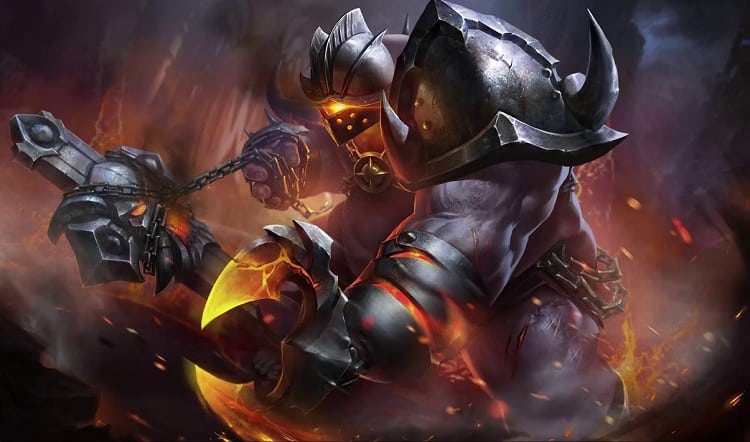
As mentioned, supports are the least item and level-dependent characters on the battlefield. Nevertheless, they are crucial for carries survival. From the laning phase onward, their task is to protect the main hero on the team and help them in a pinch with various shields and heals.
Although they have similar health and defense as marksmen, mages, and assassins, they are usually more survivable because of their spell kits. Among others, supports are also responsible for warding the map and providing vision for the team.
Tanks (Mina, Omarr, Taara, Dextra, etc.)
Tanks are very durable characters that serve as frontliners. Their main task is to initiate the fights, disable enemies, and try to survive as long as possible. Focusing on tanks is usually a mistake as it takes a lot of damage to take them down. Instead, it is much better to target other heroes on the enemy team.
Unfortunately, tanks usually suffer due to a lack of mobility. Experienced teams can simply avoid them after their initial burst/crowd control. This class usually buys defensive items but might also add some damage weapons to increase their threat level, thus forcing enemies to attack them.
Warriors (Qi, Arduin, Lu Bu, Roxie, etc.)
Warriors are a mixture of tanks and assassins. They have high durability and solid damage but usually lack mobility. They are a hybrid class that can dish a lot of damage if left to their own devices. Most fighters play carry and semi-carry roles.
Warriors perform really well against assassins as they can survive their onslaught and have enough damage to kill them off. However, they often struggle against mages and marksmen due to their ability to kite warriors.
Items
Items are crucial for the heroes’ progression. The great thing about these magical artifacts is that they provide a certain level of flexibility, allowing you to circumvent a draft disadvantage. Although each hero has their optimal build, you can sometimes win games by finding the right item mix for a particular situation.
The thing that is unique for Arena of Valor is that there is no shop in the game. You make a purchase by simply clicking on the shop icon on the left. Once you buy an item, it is automatically equipped on your hero. There are 3 tiers of items from weakest and cheapest to best and most expensive. Like in all other games, you assemble advanced items by purchasing minor components.
All items belong to 6 distinct groups:
Attack (Dawnbreaker, Astral Spear, Death Sickle, etc.)
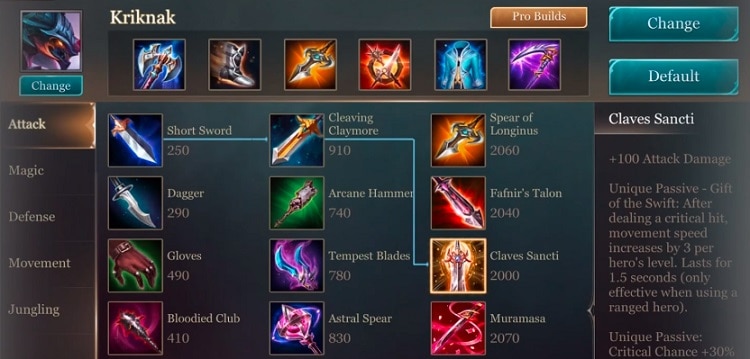
Attack items increase the offensive potential of fighters, marksmen, and other physical damage dealers. They provide various improvements such as damage, attack speed, critical strike chance, critical strike damage, movement speed, armor piercing, and various active and passive abilities.
Magic (Apocalypse, Holy of Holies, Pendant of Faith, etc.)
These items are mostly for mages, assassins, enchanters, and various hybrid builds that utilize ability power. Magic artifacts improve ability power, cooldowns, mana regeneration, magic pierce, maximum health, maximum mana, etc.
Defense (Mantle of Ra, Odin’s Will, Hercules’ Madness, etc.)
Defensive items are crucial for tanks, but you can also build them on just about any hero that lacks protection. They provide health, health regeneration, armor, cooldown reduction, and some other perks.
Movement (Enchanted Kicks, Hermes’ Select, Gilded Greaves, etc.)
Like in other MOBAs, every hero can wear a set of boots. They increase movement speed but can also provide numerous other benefits allowing you to fine-tune your build regardless of your class.
Jungling (Leviathan, Mr. Stabby, Loki’s Curse, etc.)
Jungling items are not that great in terms of the basic stats. However, they all provide certain benefits against monsters and minions. They also give heroes a permanent offensive and defensive stat boost when you kill monsters allowing a jungler to scale better.
Support (Earth Gem, Water Stone, Fire Gem, etc.)
As the name implies, support items are tailor-made for supports. They give characters a boost in gold and experience as long as they are close to other heroes.
Various Other Boosts and Enhancements
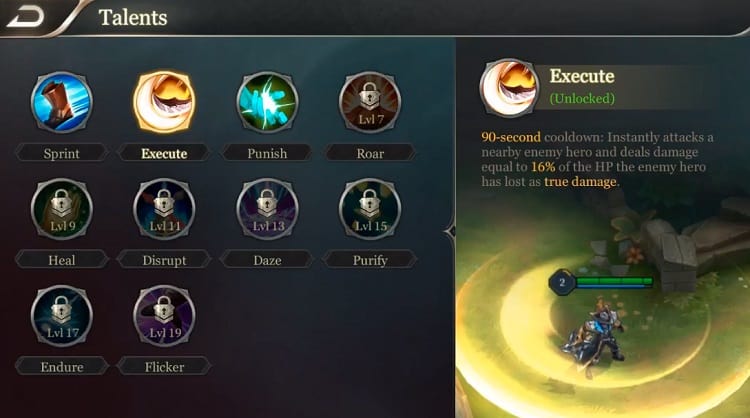
Like in League of Legends, there are other boosts and enhancements that you can set up outside of the game. We categorize them as talents, runes, and arcanas.
Talents
Talents are basically the same thing as Summoner Spells in League of Legends. You unlock them as you increase your Arena of Valor account.
Everyone has access to Recall and Restore by default, and there is a third slot where you can place a talent of your choosing. Here are all the talents in the game and when you can unlock them:
- Sprint (unlocks at level 1): Boosts movement speed by 20% for 10 seconds.
- Execute (unlocks at level 3): Causes damage in an AOE around the hero, based on 16% of enemies’ lost health.
- Punish (unlocks at level 5): Dishes 800 pure damage to an opponent and stuns them for a second. Works only on monsters and minions.
- Roar (unlocks at level 7): Boost attack damage by 10% and attack speed by 60% for 5 seconds.
- Heal (unlocks at level 9): Restores 15% health around the caster. Boost regeneration by 15% for 2 seconds.
- Disrupt (unlocks at level 11): Prevents turrets from attacking for 5 seconds.
- Daze (unlocks at level 13): Stuns enemies for 0.5 seconds and slows them for 1 second.
- Purify (unlocks at level 15): Removes all crowd control and makes a target immune to these effects for 1.5 seconds.
- Endure (unlocks at level 17): Prevents your character from taking action and makes them immune for 1.5 seconds.
- Flicker (unlocks at level 19): Short teleport.
Runes
Runes are similar to talents in the sense that you have to unlock them. They are available at level 5, and provide different passive boosts to your hero. There are four rune trees in total, allowing you to make various interesting combinations.
Veda (Great for Ranged Characters like Mages and Marksmen; a Mix of Damage and Utility)
- Tier 1: Axe of Sacrifice, Mana Refill, Sacred Bead.
- Tier 2: Holy Verdic, Blessing.
- Tier 3: Holy Thunder, Holy Summoner, Sacred Protection.
Lokheim (Great for Melee Characters like Assassins and Warriors; Focuses on Offense)
- Tier 1: Devourer, Shadow Blade, Raging Inferno.
- Tier 2: Deadly Claw, Bone Cutter.
- Tier 3: Curse of Death, Devil’s Awakening, Desperate Duel.
Afata (Great for Supports and Tanks; Ideal for Support and Control)
- Tier 1: River Treader, Backstabing, Tower Blessing.
- Tier 2: Regrowth, Nature’s Gift.
- Tier 3: Nature’s Rage Afata, Explosive Shield, Forest Wanderer.
League of Humans (Flexible Tree)
- Tier 1: Reaper’s Blessing, Mark of Frost, Arcane Whisper.
- Tier 2: Minion Kill, Gunslinger.
- Tier 3: Endless Cycle, Leveling.
Arcanas
When your account reaches level 7, you have the opportunity to add arcanas, thus increasing the overall potential of your hero. They work by improving the basic stats of your character by a little bit. We can categorize them into three groups:
- Red (increase offensive potential)
- Purple (provide mixed benefits and utility)
- Green (increase defensive potential)
There are 10 arcana slots for each one of these colors, with each arcana ranging from first to the third level, providing better and better stats. The effect of arcanas is especially noticeable during the early game. You can get them by finishing achievements or purchasing them in the store.
Best Tips for Arena of Valor
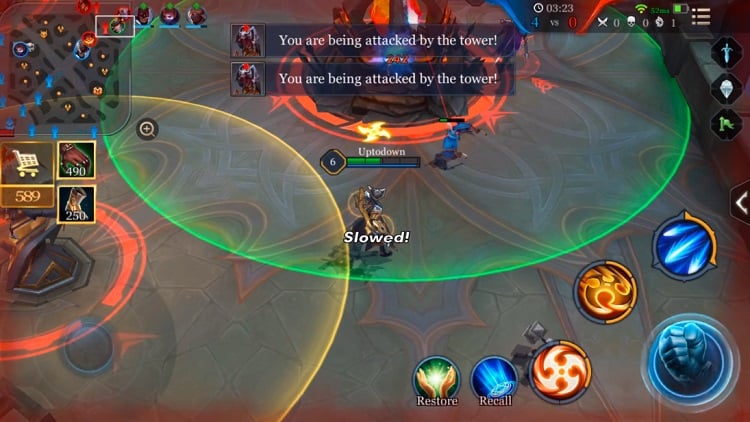
Like every MOBA, your ability to win games is determined by strategic choices, team planning, and skill level. Even if you’re not a good player, you can win a lot of games by simply understanding the basic mechanics. Here are some of the best tips that you should always keep in mind:
- A proper draft is crucial for winning games. Get a team that synergizes well together. Ideally, the most experienced player should be the team captain.
- Make sure to play the game according to your role and character.
- Optimal builds are optimal for a reason. Unless you’re an experienced player, try sticking to the popular itemizations, talent, rune, and spell builds.
- If you don’t have experience with other MOBAs, make sure to spam the same hero or group of heroes over and over again until you get the hang of basic. Playing your best heroes is especially important in ranked matchmaking, where the level of competition tends to be the highest.
- Use a microphone to communicate with your team. Tell them exactly what you want to do. Having an open chat is especially important prior to and during teamfights.
- During the mid game and late game, always go as 5, even if you’re the carry.
- Focus on taking down strategic objectives. Don’t waste too much time in mid and late game farming, especially if you’re not the carry.
- Don’t take farm from higher priority roles.
- After taking down the Dark Slayer, start pushing into enemy base. Similarly, whenever you win a teamfight, make sure to focus on the objectives instead of farming.
- Think about your positioning. If you’re too squishy, stay in the backlines. If you’re a tank, play aggressively.
- If you notice that you’re getting killed a lot, you should consider getting some defensive items. If enemies start ignoring you due to lack of damage, consider buying offensive items.
- Watch professional games and try to eliminate your mistakes. Always have a critical approach to your game.
- Don’t flame!
By following these few basic tips, you will have a much better chance of winning Arena of Valor games.
FAQs
Question: Who is the Best Hero in Arena of Valor?
Answer: Like with all MOBAs, Arena of Valor meta changes all the time, affecting the popularity of heroes. At the moment of writing this guide, heroes such as Thane, Baldum, Riktor, Veres, Quillen, Tulen, Violet, Zip, and Kriknak were among the most popular ones.
Question: How Many Heroes are in AoV?
Answer: Right now, there are a total of 112 heroes in the game. We categorize them into assassins, marksmen, support, tanks, warriors, and mages.
Question: Is Arena of Valor Still Popular?
Answer: Arena of Valor remains the most popular mobile MOBA. Although its popularity cannot compare to Dota 2 and League of Legends, it has done really well for itself within the mobile niche.
Arena of Valor Game Overview: Conclusion
Arena of Valor is the most popular mobile MOBA. In terms of the system, it resembles League of Legends. Currently, there are 112 heroes available, split into 6 categories. The goal of the game is to destroy enemy towers, penetrate the enemy base, and destroy their Core building.
Although Arena of Valor features numerous modes, the most popular one is the Grand Battle or Antaris Battlefield. This is a 5 vs. 5 map where matches last from 12 to 20 minutes. It is a very dynamic mode that finishes relatively quickly but has a very competitive nature.

